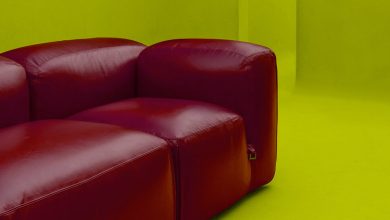Inside a Grand Parisian Building, a Secret Atelier

On a quiet stretch of the Rue Saint-Lazare, shielded from the commotion of the nearby Paris train station that shares the street’s name, there’s an ornate 1880s Haussmann-style building with a delicately carved limestone facade. It’s by far the grandest building on this Ninth Arrondissement block — and thus an unexpected home for Saint-Lazare, a product and design firm best known for its utilitarian aesthetic and stylish use of humble materials.
It’s here, just beyond a stately interior courtyard, that 25 young designers crowd around one of three long communal wooden trestle tables, surrounded by plywood shelves holding rows of cardboard archive boxes. Practically every surface of the 1,800-square-foot room is covered with tableaus of Saint-Lazare products: Vintage travel posters and colorful Op Art prints lean three deep against one wall next to a stack of boldly striped wool blankets; pocket-size travel guides and soft leather pouches line bookshelves. The wall opposite is papered over with promotional posters for many of these same objects — a homage to the advertising kiosks that once filled the city’s street corners — upon which are painted the firm’s logo.
“If you’re willing to push on some doors in this district, you’ll find many beautiful things happening,” says Clémentine Larroumet, a designer who co-founded the firm with her childhood friend the Parisian architect Antoine Ricardou. For the past two decades, the duo, both in their late 40s, ran a studio called Be-Poles, which was known for branding and helping design cosmopolitan hotels like the NoMad in New York and Le Pigalle in Paris, as well as several collaborations with Pierre Bergé and Yves Saint Laurent.
Even back then — when Be-Poles might have been involved in, say, a hotel’s signage or letterhead but not necessarily its interiors — the pair had begun making products on their own “because we wanted to,” Larroumet says. “We would see something lacking in the market and be the ones to create it.” First among these was “Portraits de Villes,” an ongoing series of tiny books that match a different artist with a different city (the photographer Lina Scheynius with Sarajevo; the illustrator Iris de Moüy with Kyoto). In 2010, shortly after the launch of Be-Poles’s New York studio, now led by associate partner Reynald Philippe, the company was hired to work on brand identity for the NoMad; as the Jacques Garcia-designed project neared completion, the Be-Poles art curator Virginie Boulenger decorated its walls with photography from its previously published guides, alongside old prints of cityscapes and retro travel posters. “Suddenly, we were choosing art, hanging pictures and placing objects on tables,” Ricardou says. “It went from creating an abstract concept to touching all the surfaces.”
In the years since — whether they were working on Les Roches Rouges, a chic resort on the French Riviera, or Le Barn, a country getaway outside Paris — the partners have become experts at sourcing vintage objects and fabricating furniture and lighting on behalf of hospitality clients. About a year ago, in the middle of the pandemic, they decided to produce more of their own objects and rebranded as Saint-Lazare, moving from the top of a building across from the Centre Pompidou into their ground-floor studio. “We wanted the creative energy of a large space, where the team can experiment, prototype ideas, print their own artwork — there’s even a kiln for firing ceramics,” Ricardou says.
That dedication to experimentation and collaboration informs the design itself. There are no assigned seats, and virtually every corner is made for flexible, multipurpose use. At the center of the space is a white-tiled kitchen, where colleagues and clients can meet for coffee or chat with a chef who has come by to cook lunch. Lately, Saint-Lazare has been making wooden furniture — a simple bench for the foot of a bed; a matching trestle upon which to fling clothes; boxy stools — that adds touches of warmth and life. But as with any good design, the idea is that none of this — not the objects nor the place in which they’re dreamed up — feels designed per se. “The goal,” says Larroumet, “is to create only things that have a purpose, that are true to their function and that are timeless.”
Photo assistant: Michael Campi



